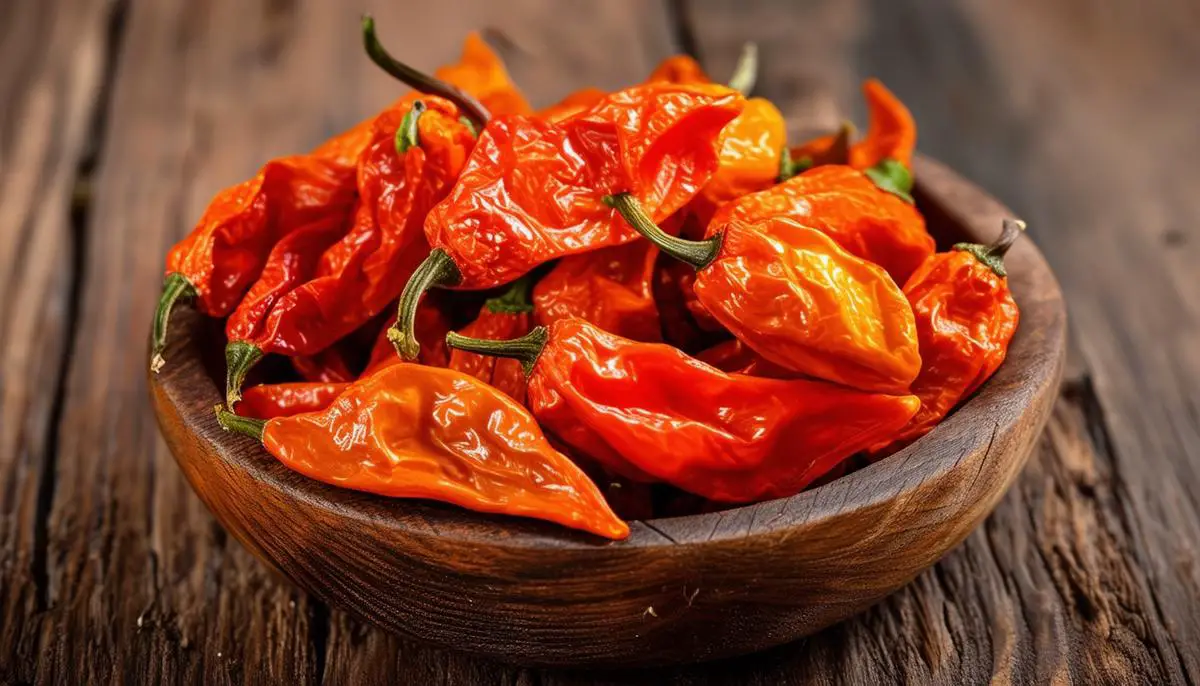
Understanding Habanero Peppers
Habanero peppers, with their scorching heat level ranging between 100,000 and 350,000 on the Scoville scale, stand out not just for their ability to make your forehead sweat but also for their fruit-like flavor and brisk flowery aroma. Deceptively vibrant in appearance, these peppers harbor thin outer walls—an attribute that is both a benefit and a challenge in the drying process.
The thinness of the habanero’s walls allows for quicker drying compared to thicker-skinned varieties. This is a significant advantage as prolonged exposure to heat can degrade the pepper’s oils, which are essential for flavor. However, their fiery nature demands careful handling; even when dried, the oils can retain heat and piquancy.
When drying habaneros, the bright color of these chilies often fades to a muted tan or pale hue, indicating that they have lost a fraction of their moisture content but not their zesty spirit. The transformation not only preserves them for longer cooking applications but also mellows their heat without stripping away the distinctive fruity notes.
Full sun drying, a popular method, ensures habaneros retain their characteristic punch. This method engages natural heat to coax out water content while sealing in robust flavors. However, patience is key. Rushing this process through unnatural heat sources can cook away the delicate balance of fire and fruit that habaneros are celebrated for.
A secondary beneficial method particularly suited for those with a penchant for culinary experiments involves oven drying—setting the dial just low enough, about 120 – 140 degrees Fahrenheit. This controlled environment allows for precise moisture reduction without endangering the flavor-aligned compounds critical for that habanero heat experience.
Once dried, storing them becomes a tale of preservation; kept away from light and moisture, these dried peppers can lurk in your pantry, ready to transform a humdrum meal into a launch of flavors, proving that sometimes the most impactful things come in the smallest, driest packages.
Methods of Drying Habanero Peppers
In addition to sun-drying and oven drying, dehydrating offers a third and highly reliable technique for drying habanero peppers. Dehydration, whether using a dedicated food dehydrator or various adapted home methods, enables more consistent airflow and temperature control, a distinct asset in achieving uniformly dried peppers while preserving their intense heat and vivid flavors.
Utilizing a dehydrator is particularly effective for those in humid climates where sun-drying may prove slow or ineffective. Since these devices generate adequate and steady heat with controlled ventilation, they mitigate the risk of mold, a common enemy in pepper drying which thrives under moist conditions. Importantly, dehydrators can hasten the process considerably without sacrificing the oil concentration that fuels the pepper’s spicy profile.
However, while the advantages of dehydrating are considerable, it is not without drawbacks. The primary disadvantage is the cost of equipment. For the hobby chef or occasional spice enthusiast, the investment in a specialized appliance might feel excessive. Moreover, energy consumption and the footprint of an additional kitchen gadget may deter those striving for minimalism or lower utility bills.
Oven drying allows for solid control over air circulating around the peppers and is a compromise on equipment investment. Additionally, oven drying does not generally require sunny weather, making it ideal for kitchen warriors in less sunny locales. Yet this method is not free from flaws—uneven oven spots may demand frequent pepper rotation for balanced drying, and maintaining a low continuous temperature could spike your energy usage slightly higher than anticipated.
Choosing the proper method to dry habanero peppers can depend largely on individual circumstances including climate, available resources, desired intensity of the finished product, and personal preference. Ultimately, whether one dries peppers in the embracing heat of solar rays, the controlled confines of a modern dehydrator, or the ubiquitous household oven, each contributes uniquely to our culinary canvases, vibrant dashes of color to piquant plates worldwide.
Using Dried Habaneros
Mastering the culinary application of dried habaneros can elevate your dishes to a level of distinction and complexity. The concentrated heat and profound, fruity under-notes of this chili make it an exceptional candidate for creating deep, resonating flavors in a variety of recipes.
One of the most straightforward yet transformative uses of dried habaneros is as homemade chili powders or flakes. By grinding the peppers finely, these potent powders become invaluable allies in the kitchen, perfect for sprinkling into meats, seafood marinades, or vegetable stews. The smoky yet tropical backdrop of habaneros integrates seamlessly into virtually any dish demanding a kick. For the adventurous home chef, a dash or two doesn’t just hint at heat; it also marries beautifully with sweeter elements like chocolate or fruit-based desserts, delivering an unexpected flair.
Dried habanero flakes, slightly coarser than their powdered counterparts, can be used as a finisher or folded into bread doughs for a revved-up version of your habitual bakes. Mixing these flakes into fresh burger patties or even a simple pasta aglio e olio delicately orchestrates a crescendo of flavors; starting subtle and finishing with assurance.
The versatility of dried habaneros extends beyond dry rubs. Envision the power of pivotal sauces and dressing transformations — habanero-laced salsas guaranteed to enliven even the most mundane tortilla chip or a roasted habanero garlic aioli where the slight acidity of garlic balances the heat of the habanero, creating unparalleled pairings for burgers, veggies, and everything in between.
- Consider the dynamic duo of dried habaneros combined with mangos in a mango-habanero hot sauce that unites the savory with the sweet and heat. Perfect as a glaze over bbq ribs or as a stirring element in exotic cocktail creations.
- For chutney enthusiasts, a habanero pineapple version carries crunch and spiciness, rounding out charcuterie boards or simply as a spirited companion to curry dishes.
- And why not reinvent classic condiments? Homemade mustard that employs finely milled dried habaneros can transform a standard condiment into an adventurous spread enticing enough to become the highlight of any dinner table discussion.
Culinary artists drawn towards unconventional uses might explore brewing dried habaneros into infused oils that promise layers of tang and a fiery burst in every drop, elevating simple salad dressings to thrilling new heights, or even anchoring the elusive perfect spice in global dishes ranging from Italian to Caribbean delights.
As you integrate dried habaneros into your cuisine canon, consider engaging them carefully, starting with modest amounts; their explosive character is luxurious when mellowing into existing flavors—yet can easily overwhelm. It’s this potent potential, however, that when harnessed, rounds out the edges and additions to your next culinary masterpiece—a memorable meal woven with the fiery drama and distinct silhouette of dried habanero chilies.
Storage and Preservation
Once the habanero peppers are successfully dried, their journey into culinary profundity is not over. The same careful attention used during the drying process must extend into their storage to preserve their quality and potency. The principles of habanero storage are straightforward, yet they play a critical role in maintaining the peppers’ fiery essence and distinctive aromatic palette.
The first principle of storing dried habaneros—or any spices, for that matter—is keeping them away from light. Light can degrade the piquant oils intrinsic to habaneros’ heat and flavor, resulting in a flattened and uninspiring culinary addition. Thus, opting for opaque, air-tight storage containers is a prudent choice. Such conditions shield the habaneros from harsh lighting while also reducing exposure to air, which can carry moisture or contaminants that might compromise the spice’s intensity.
Speaking of moisture, it is a formidable enemy in spice storage. Even slight humidity can reintroduce water into the dried peppers, leading to mold or mildew—an absolute disaster for dried spices. To prevent this, ensure that habaneros are stored in a cool, dry environment. Silica gel desiccants can be helpful in this regard, especially if one resides in particularly humid climates. By absorbing stray moisture, these small packets help maintain a dry environment within the storage container.
The packaging of dried habaneros should not be an afterthought. Vacuum-sealed bags serve well for long-term storage as they effectively prevent air and moisture exposure. For those lacking vacuum sealing apparatus, heavy-duty zip-top plastic bags can suffice, provided all possible air is pressed out before sealing. Repeated exposure to air when opening and closing containers can hasten quality decline, so keeping a smaller “working supply” on hand for everyday cooking while the larger bulk remains sealed can minimize this effect.
In terms of shelf life expectations, dried habaneros, when stored correctly, can maintain potency for up to two years without substantial loss of heat or essence. However, the true culinarian will observe subtle nuances and may prefer usage within a year for peak vibrancy. Over time, the peppers can lose their intricate fruity notes, descending into mere shadows of their former selves in fieriness and flavor complexity.
Regular monitoring and good organizational practices are also invaluable. Date labels are a must, enabling one not only to rotate stock based on age but also to ensure no spices linger beyond their optimum performance period. Rotate your habaneros thoughtfully and carefully.
Through proper preservation techniques and respect for each phase in their lifecycle, your habanero peppers can remain veiled kings in your culinary arsenal—fiery, fruity, and always ready to transform the mundane into something mesmerizing on your plate.
- Bosland PW, Votava EJ. Peppers: Vegetable and Spice Capsicums. 2nd ed. CABI Publishing; 2012.
- Berke T, Black LL, Talekar NS, et al. Suggested Cultural Practices for Chili Pepper. AVRDC Publication. 2005;05-620.
- Barrios EAZ, Vasquez LMR, Villalobos CO, Campos PG, Hernandez DJ. Drying Kinetics of Habanero Chili Pepper (Capsicum chinense) Using a Hothouse Type Solar Dryer. Appl Eng Agric. 2019;35(6):949-957.



